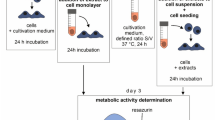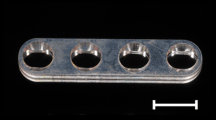Abstract
When studying the biocompatibility of orthopaedic biomaterials it isoften necessary to discriminate between responses which show mild cytotoxicity.It is therefore essential to use a very sensitive index of toxicity. We havecompared the sensitivity of four well-established indices of toxicity: totalcell protein content, leakage of lactate dehydrogenase (LDH), reducedglutathione content and the MTT assay, with that of a novel index, alkalinephosphatase (ALP) activity. Comparisons were made by detecting nickel chloridetoxicity in osteoblasts. ALP activity, the novel method, proved the mostsensitive index of toxicity and it provides a convenient automated assay forassessing the interactions of materials with osteoblasts. The responses tonickel chloride and to aqueous extracts prepared from carbon fibre reinforcedepoxy and polyetheretherketone (peek), two candidate materials for orthopaedicimplants, were compared in primary and immortalized rat osteoblasts, and !in primary human osteoblasts. Although the immortalized rat osteoblast cell line,FFC, was consistently the most sensitive cell type, the responses of the humancells and the FFC cell line were similar in terms of ALP activity throughout therange of nickel concentrations studied. Neither peek nor epoxy material extractsshowed a significant decrease in the MTT or ALP responses in any of the threecell types. Our data suggest that immortalized rat osteoblasts may provide anin vitro model system for screening the biocompatibility of orthopaedicpolymers.
Similar content being viewed by others
References
J. CARMICHAEL, W. G. deGRAFF, A. F. GAZDAR, J. D. MINNA and J. B. MITCHELL, Cancer Res. 47 (1987) 936.
M. C. ALLEY, D. A. SCUDIERO, A. MONKS, M. L. HURSEY, M. J. CZERWINSKI, D. L. FINE, B. J. ABBOT, J. G. MAYO, R. H. SHOEMAKER and M. R. BOYD, ibid. 48 (1988) 589.
H. WAN, R. WILLIAMS, P. DOHERTY and D. F. WILLIAMS, J. Mater. Sci. Mater. Med. 5 (1994) 154.
M. D. SMITH, J. C. BARBENEL, J. M. COURTNEY and M. H. GRANT, Int. J. Art. Org. 15 (1992) 191.
J. A. PLUMB, R. MILROY and S. B. KAYE, Cancer Res. 49 (1989) 4435.
A. MEISTER. In “The liver: biology and pathobiology”, edited by I. M. Arias, W. B. Jakoby, H. Popper, D. Schachter and D. A. Shafritz (Raven Press, New York, 1988) p. 401.
L. D. DORR, R. BLOEBAUM, J. EMMANUAL and R. MELDRUM, Clin. Orthop. Res. 261 (1990) 82.
U. E. PIZZAGLIA, C. MINOIA, L. CECILIANI and C. RICCARDI, Acta. Orthop. Scand. 54 (1983) 574.
M. H. GRANT, C. NUGENT and R. BERTRAND, Toxicol. In Vitro 8 (1994) 191.
L. J. BEARDEN and F. W. COOKE, J. Biomed. Mater. Res. 14 (1980) 289.
C. J. KIRKPATRICK, W. MOHR and O. HAFERKAMP, Res. Exp. Med. 181 (1982) 259.
C. MORRISON, R. MACNAIR, C. MACDONALD, A. WYKMAN, I. GOLDIE and M. H. GRANT, Biomaterials 16 (1995) 987.
C. MACDONALD, M. VASS, B. WILLETT, A. SCOTT and M. H. GRANT, Human Exp. Toxicol. 13 (1994) 439.
M. H. GRANT, N. GRANGER and C. MACDONALD, Brit. J. Clin. Pharmacol. 38 (1994) p. 172.
I. BINDERMAN, D. DUKSIN, A. HARELL, E. KATZIR and L. SACHS, J. Cell Biol. 61 (1974) 427.
U. KREUZBURG-DUFFY and C. MACDONALD, Immunology 72 (1991) 368.
D. C. ANUFORO, D. ACOSTA and R. V. SMITH, In Vitro 14 (1978) 981.
R. J. HISSIN and R. HILF, Anal. Biochem. 74 (1976) 214.
O. H. LOWRY, N. J. ROSEBROUGH, A. L. FARR and R. J. RANDALL, J. Biol. Chem. 193 (1951) 265.
N. F. HARMAND, L. BORDENAVE, R. BAREILLE, A. NAJI, R. JEANDOT, F. ROUAIS and D. DUCASSOU, J. Biomater. Sci. Polymer Edn 2 (1991) 67.
A. PIZZOFERRATO, G. CIAPETTI, S. STEA, E. CENNI, C. R. ARCIOLA, D. GRANCHI and L. SAVARINO, Clin. Mater. 15 (1994) 173.
L. M. WENZ, K. MERRITT, S. A. BROWN, A. MOET and A. D. STEFFEE, J. Biomed. Mater. Res. 24 (1990) 207.
K. A. JOCKISH, S. A. BROWN, T. W. BAUER and K. MERRITT, ibid. 26 (1992) 133.
Author information
Authors and Affiliations
Rights and permissions
About this article
Cite this article
MACNAIR , R., RODGERS , E.H., MACDONALD , C. et al. The response of primary rat and human osteoblasts and an immortalized rat osteoblast cell line to orthopaedic materials: comparative sensitivity of several toxicity indices. Journal of Materials Science: Materials in Medicine 8, 105–111 (1997). https://doi.org/10.1023/A:1018510900941
Issue Date:
DOI: https://doi.org/10.1023/A:1018510900941




